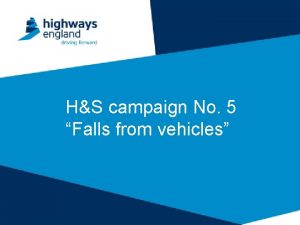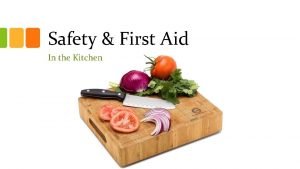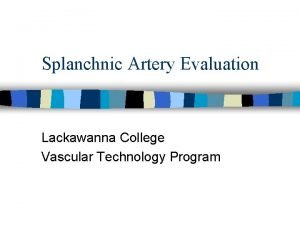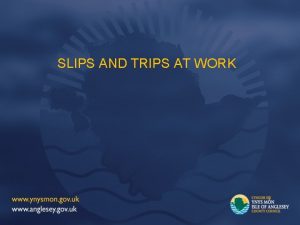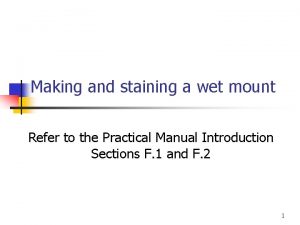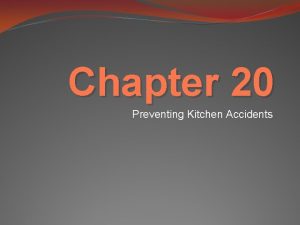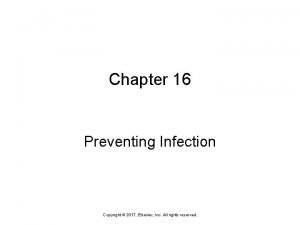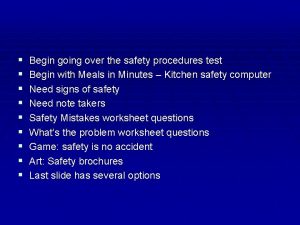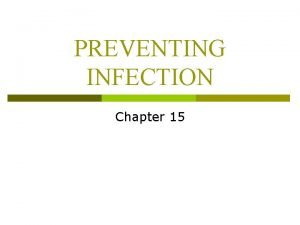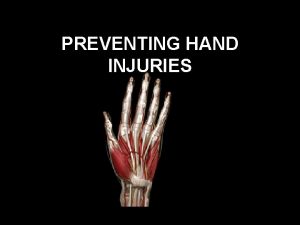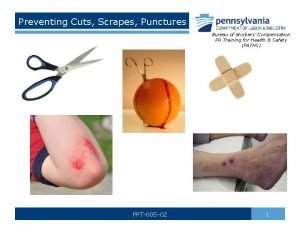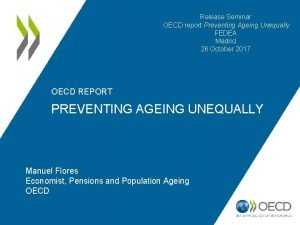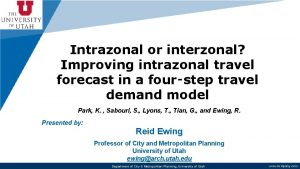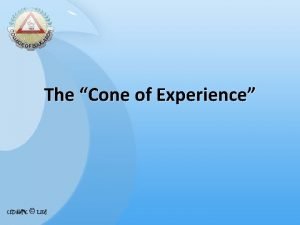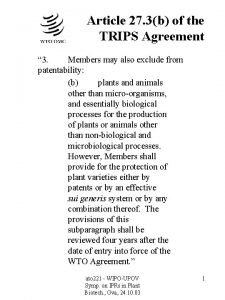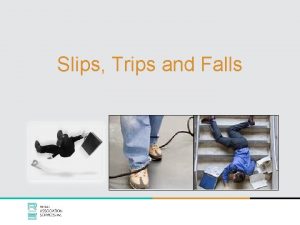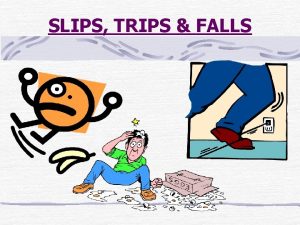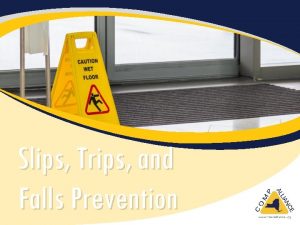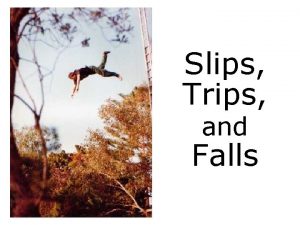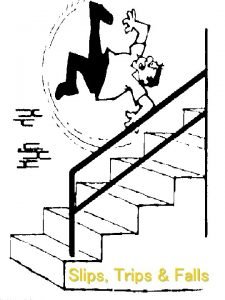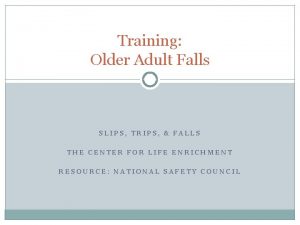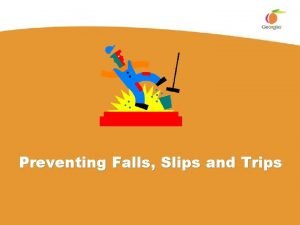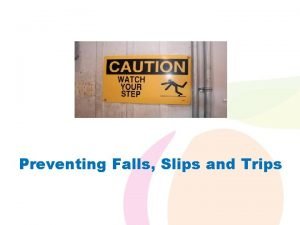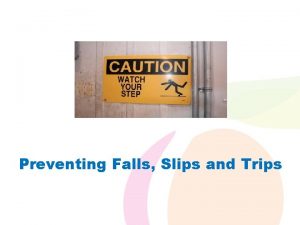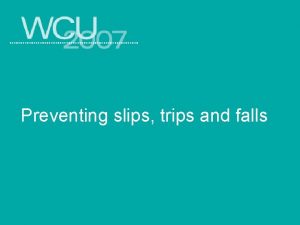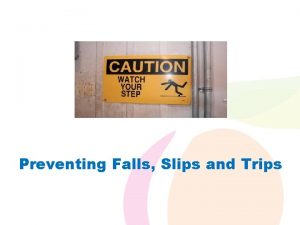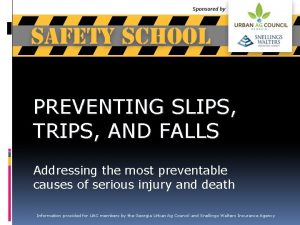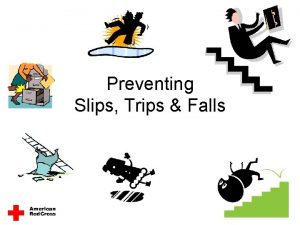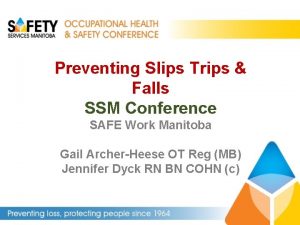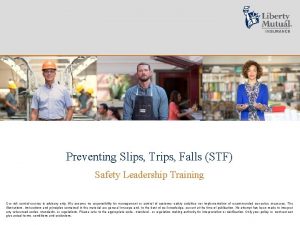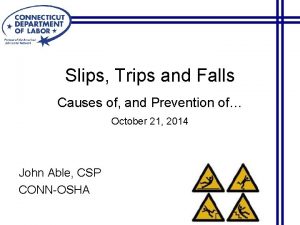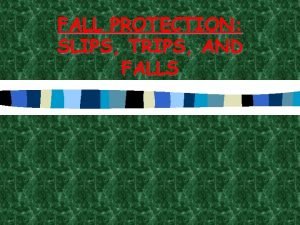Preventing Slips Trips and Falls Douglas Linz MD



































- Slides: 35

Preventing Slips, Trips, and Falls Douglas Linz, MD, MS Medical Director Tri. Health Corporate Health

Learning Objectives In this module participants will learn: 1. Slip, Trip and Fall Statistics and Costs 2. Injuries resulting from Slips, Trips and Falls 3. Definitions of Slips, Trips and Falls 4. Causes of Slips, Trips and Falls 5. 3 Steps for Preventing Slips, Trips and Falls 6. Behaviors for Preventing Slips, Trips and Falls

Slips, Trips & Falls (STF’s) Statistics According to the U. S. Department of Labor, Slips, Trips, and Falls make up the majority of general industry accidents. • 15% of accidental deaths are caused by Slips, Trips and Falls, second behind MVA’s • 15% to 20% of all workers compensation costs are due to Slips, Trips and Falls • About 25% of all Worker’s Compensation Claims

Common Injuries from STF’s Types of Injuries Back/spine Head/brain Muscle strains Sprains Broken bones Death

Costs of STF’s- Worker • To the worker: – Lost wages & out-of-pocket expenses – Pain – Temporary or permanent disability – Reduced quality of life – Depression – Death

Costs of STF’s- Employer • To the employer: – Loss of production & business – Higher insurance costs – Costs of training replacement workers

Definition: Slip • Slips occur when there is too little friction or traction between your feet (footwear) and the walking or working surface, and you lose your balance. . • Slips can result in falls & severe injuries even when there is no fall

Definition: Trip • Trips occur when your foot (or lower leg) hits an object and your upper body continues moving, throwing you off balance. or

Definition: Trip • When you step down to a lower surface and lose your balance.

Definition: Fall • Falls occur when you are too far off your center of balance – either at the same level or a lower level.

Causes: Slips 1. Items on floors or walking surfaces Product, Fat, Feathers, Cardboard, Plastic, Water 2. Walking from one surface onto another: tile to vinyl, carpet to vinyl, concrete to tile 3. Sloped walking surfaces 4. Loose rugs or floor mats 5. Ramps without slip resistant surfaces 6. Climbing up and down ladders

Causes: Slips 7. Boots and shoes with wet, greasy or oily soles 8. Walking from one area to another - from processing area to cooler or freezer 9. Climbing on and off trucks, trailers and forklifts 10. Weather hazards – rain, sleet, ice, snow, hail, frost – Wright Patterson – AFB, Museum, Hospital, University 11. Improper or worn out footwear

Causes: Trips, Falls 1. Items and obstacles in or across aisles and walkways: wash down hoses, pallets, employee stands, electrical cords, pallet jacks, boxes/combos/vats 2. Changes in elevation or levels: steps, stands, ramps 3. Rumpled or rolled up floor mats or carpet 4. Steps: damaged, uneven or irregular, missing 5. Uneven surfaces, things protruding from surface 6. Floor drain covers – missing, broken, or not properly in place

Unsafe Conditions • • • Poor lighting Glare Shadows Bulky PPE (Respirators!) Improper footwear Excess noise or temperature Fog, ice or misty conditions Poor housekeeping Improper cleaning methods & products – Hospital OR • Inadequate or missing signage • Open drawers • Poorly maintained floors

Unsafe Behaviors • Carrying or moving cumbersome objects or simply too many objects at one time • Not paying attention to surroundings or walking while distracted • Taking shortcuts – not using designated walkways • Being in a hurry and rushing • Not observing posted signage • Entering unauthorized or restricted areas • Distractions related to health, pain, stressors at home and work

Aging Workforce – Effects on Safety • Vision - Aging reduces the light entering the eye by clouding the optics and by shrinking the pupil - 60 yr old perceives 1/3 rd as much light – yellowing, drooping eyelids • Therefore – improve illumination – especially at tops and bottoms of stairwells, high contrast between risers & treads, use non-slip surfaces on treads • Reduce glare, avoids shades of blue, blue on green or blue on black for signage, increase font size, black on white better than white on black, place signs appropriately in light of changes in visual fields

Aging Workforce – Effects on Safety • Age-associated changes in physique – don’t let political correctness interfere with safety goals • Ability to recover balance with slips and falls – greatly reduced • Reduce weight of objects that need to be carried; provide handles, arrange work to reduce need to carry over distances, particularly up and down stairs, out of doors • Avoid marble, polished wood and tile flooring, particularly if it may become wet

What’s Wrong with This Picture?

What’s Wrong with This Picture?

What’s Wrong with This Picture?

What’s Wrong with This Picture?

Three Steps for Preventing – STF’s PREVENT • Unsafe Conditions • Unsafe Behaviors STEP #1 STEP #2 STEP #3

OSHA Regulations 29 CFR 1910 Subpart D • • • Housekeeping Aisles Floor openings Wall openings Open-sided floors Stairways Railings Fixed stairs Portable ladders

Prevention • Use handrails going up AND down stairs • Double step when walking up and down slippery stairs – avoid stairs when possible – e. g. Is there another entrance?

Prevention • Keep footwear snug – tied, clean and in good repair • Rubber, non-slip treads – in good condition – Nix slippery high-end leather soles • Wear proper footwear for weather to and from work – change into heels, dress shoes when necessary • Keep feet warm (improves sensation) • Consider the relative cost of purchasing high quality footwear for high risk employees Woman’s Work Shoe by Lola

Prevention • Drop the load if carrying when slip or trip! • Institute JDI – “just do it” approach to correcting/reporting safety hazards, including “lock out tag out” equivalents • Be aware of work stand heights, positions and levels • Adjust behaviors according to changes in physical shape, size, eyesight, hearing, balance, strength, conditioning, flexibility

Prevention • Clean up spills immediately, mark and cordon off slippery areas or areas with temporary trip hazards. • Roll up hoses, wires, and other obstructions immediately following use • Keep walkways, stairs, work areas, aisles clear • Inspect and maintain fixed and portable ladders, review ladder safety procedures regularly • Use proper equipment for moving loads

Prevention • If you do fall bend your elbows and knees and use your legs and arms to absorb the fall; protect your head • Get medical attention after a fall if potentially injured • Let yourself crumble & roll with the fall; don’t reach out • Learning to fall properly often doesn’t prevent injuries

Prevention • Importance of wellness and wellbeing – 30% reduction in work-related accidents in employees AFTER they enrolled in workplace health promotion activities – Dow • Improved sleep, alertness, attention to personal safety and safety of others • Consider return to work assessments after employees return to work following injuries and illnesses • Institute non-punitive response practices to reports of breaches of safety rules, near misses, etc.

Workplace & Work Process Design • Contain work processes to prevent discharge, splatter, or spillage of liquids, oils, particles, dusts & offal onto floor – – – Local exhaust ventilation Extraction/collection systems Enclosures Work surfaces with raised or lipped edges Catch/drip pans, drain-offs

Workplace & Work Process Design • Use drip trays to contain leaks of lubricant onto floor from machinery • Perform regularly scheduled maintenance • Use adequate ventilation to avoid smoke, steam & condensation of water & grease onto floor • Provide effective drainage, false floors or work platforms • Install slip-resistant floors in high risk areas

Ice, Sleet, Snow • 42, 480 Work Injuries involved ice, sleet & snow and that required at least one LWD in 2014 – 82% from falls at the same level • OSHA has consistently determined that slips and falls in parking lots and walkways are to be considered work-related injuries • Average worker’s compensation claim for an ice related injury in a recent season was $48, 000

Ice, Sleet, Snow • Prevention – clear snow and ice ASAP; beware of “black ice” and freezing fog/mist; spread deicer ASAP after storms and pretreat • Arrange necessary outdoor walking with attention to weather and road/sidewalk/parking lot conditions • Posting signs, lighting, signal lights • Messaging – entry and exit points, at the beginning and conclusion of meetings

Tri. Health Occupational Medicine Work-Related Medical Care Where and When You Need It Central Call Center: 513 853 1040 • Arrow Springs 100 Arrow Springs Blvd. , Ste. 1200 Lebanon, OH 45036 • Butler County 8500 Bilstein Blvd. Hamilton, OH 45015 • Eastgate 4452 Eastgate Blvd. , Ste. 101 Cincinnati, OH 45245 • Norwood 4592 Montgomery Rd Cincinnati, OH 45212 • Queensgate 1150 W. 8 th St. , Ste. 120 Cincinnati, OH 45203 • Sharonville 3801 Hauck Rd. Cincinnati, OH 45241 Tri. Health Priority Care: After-Hours Care Physician-staffed, walk-in care for non-life-threatening injuries Priority Care Mason 8350 Arbor Square Dr. Mason, OH 45040

Contact Information Douglas Linz, MD, MS Cell: 513 -646 -6854 Email: Douglas_Linz@Tri. Health. com Please use this information as you wish.
 Slips trips and falls presentation
Slips trips and falls presentation Hse slips trips and falls video
Hse slips trips and falls video Importance of first aid in the kitchen
Importance of first aid in the kitchen Median arcuate ligament
Median arcuate ligament Pflegeberatung linz-land
Pflegeberatung linz-land Welches bundesland hat linz als hauptstadt
Welches bundesland hat linz als hauptstadt Kohärenz
Kohärenz Schulterambulanz linz
Schulterambulanz linz Folienpool linz
Folienpool linz Kanalisierung linz
Kanalisierung linz Linz ag kanal
Linz ag kanal Detention slips
Detention slips Work slips
Work slips How to add a stain to a wet mount slide
How to add a stain to a wet mount slide Freudian slip meaning
Freudian slip meaning Freudian slips
Freudian slips Freudian slips
Freudian slips Chapter 24 lesson 2 preventing and treating stds
Chapter 24 lesson 2 preventing and treating stds Chapter 9 resolving conflicts and preventing violence
Chapter 9 resolving conflicts and preventing violence Chapter 14:2 preventing accidents and injuries
Chapter 14:2 preventing accidents and injuries Chapter 9 resolving conflicts and preventing violence
Chapter 9 resolving conflicts and preventing violence Chapter 13:2 preventing accidents and injuries
Chapter 13:2 preventing accidents and injuries Chapter 20 preventing kitchen accidents
Chapter 20 preventing kitchen accidents Chapter 16 preventing infection
Chapter 16 preventing infection Preventing kitchen accidents worksheet
Preventing kitchen accidents worksheet Robert vischer empathy theory health and social care
Robert vischer empathy theory health and social care Chapter 4 preventing injuries through fitness
Chapter 4 preventing injuries through fitness Chapter 15 preventing infection
Chapter 15 preventing infection Preventing hand injuries
Preventing hand injuries Workers compensation puncture
Workers compensation puncture Preventing ageing unequally
Preventing ageing unequally Which is mainly responsible for preventing erosion
Which is mainly responsible for preventing erosion Interzonal and intrazonal trips
Interzonal and intrazonal trips Cone of experience
Cone of experience Normandy school trip
Normandy school trip Article 27 of trips
Article 27 of trips

